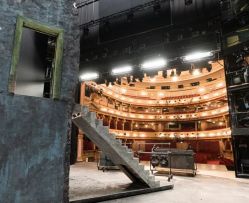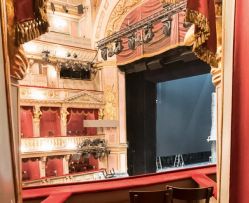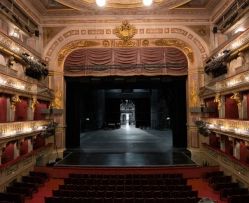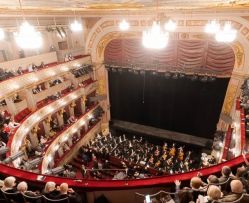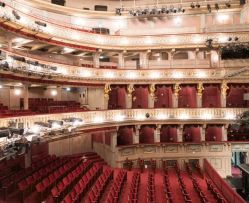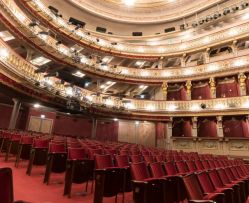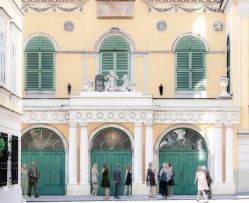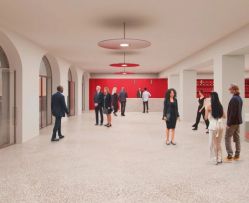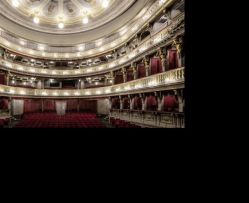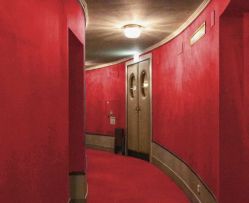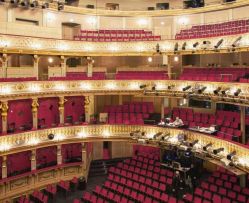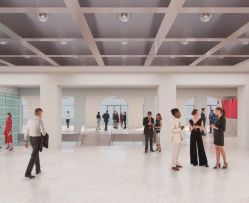Refurbishment
of the Theater an der Wien
Reopening on 12 October 2024
The Theater an der Wien, part of Vereinigte Bühnen Wien (VBW), a company of Wien Holding, is one of Vienna’s most beautiful and historically significant theatres. Since 2006 it has operated as an innovative stagione opera house of international standing. Between 2022 and 2024, this historic theatre will be completely renovated and modernised while preserving listed original components.
“We feel proud and privileged that the VBW can produce stage works at the Theater an der Wien, a site of major cultural significance owned by the City of Vienna,” says Franz Patay, CEO of the Vereinigte Bühnen Wien. “It is important to us to preserve the opera house’s unique history and aura and optimise it for future stage spectacles. Our thanks go to the representatives of the City of Vienna and Wien Holding who make it possible for us to fulfil our responsibilities with regard to this cultural heritage.”
“Schikaneder, Beethoven, Offenbach, Nestroy, Strauss, Lehár and Marie Geistinger are just some of the geniuses who performed at the Theater an der Wien and whose presence is still felt in the venerable walls of what was once the theatre in Vienna’s suburbs,” says Stefan Herheim, artistic director of the Theater an der Wien. “Preserving this cultural monument is consequently an investment in values on which the freedom of art, and therefore the art of freedom, rest. As the newly appointed artistic director of the Theater an der Wien I have a burning desire to unite the past and the future here in the present, in art and through art, in such a way that the importance of renovating the building is incontestable.”
The last time the Theater an der Wien was renovated from top to bottom was 1962. Refurbishment and repairs to certain parts of the building were carried out over the course of the following decades, chiefly in periods when there were no performances. Now the time has come for a comprehensive and lasting refurbishment of the building, inside and out, to preserve the historic opera house for the coming decades, to meet the requirements of patrons, artists and staff in terms of safety and comfort, and to ensure state-of-the-art operatic performances for a long time to come. The work will be carried out in accordance with the preservation orders to which parts of the theatre, such as the so-called Papageno Gate on Millöckergasse and the auditorium, are subject.
Major joint undertaking by the City of Vienna, Wien Holding and Vereinigte Bühnen Wien
“Vienna is one of Europe’s top cities for culture and it is not least for this reason that we are committed to massive investment in the future of our theatres,” says Peter Hanke, councillor responsible for the economy and finance on Vienna city council. “We have already done this with the Ronacher and more recently with the Raimund Theater, which has presented itself in renewed splendour since 2021. And this is a sound investment because it not only enhances the quality of Vienna as a city of culture and tourism, but also creates added value and safeguards jobs.”
“The renovation and modernisation of the historic theatre is urgently needed to make the opera house fit for the future for many years to come,” says Wien Holding CEO Kurt Gollowitzer. “The refurbishment includes improvement of the fabric of the building, the plumbing and electrics, renovation of the front and rear, its opening onto Naschmarkt and construction of a traffic-calmed zone in Millöckergasse. The makeover will take about two years, and then the theatre can reopen, newly resplendent, in autumn 2024.”
“The Theater an der Wien is a pivotal opera house whose reputation spreads far and wide,” says Veronica Kaup-Hasler, councillor responsible for culture. “This is reflected in the fact that 93% of tickets were sold in the years before Covid, but also by the numerous international accolades and co-productions. To ensure that this successful, historic opera house has an equally dazzling future, modernisation is necessary. I’m delighted that the City of Vienna is taking its cultural responsibilities seriously and has provided the funds required for the urgently needed renovation of the historic theatre.”
“As we did with the extensive refurbishment of the Raimund Theater, we as a district would like to take the opportunity to make public space more attractive,” explains Markus Rumelhart, council leader in Vienna’s 6th district. “Together with the Vereinigte Bühnen Wien we want to create a modern entrance to the new opera house for its patrons as well as an attractive street layout for the residents.”
From the facade to the front and rear; from the foyer to the interior; from the plumbing and electrics to the fabric of the building and its “opening” onto Naschmarkt
In detail, the complete renovation and modernisation concerns the following parts of the historic theatre:
- renovation of the facades in accordance with the requirements of the Office for the Care of Monuments
- draining measures
- urgently required new safety and fire protection installations (fire-containment sections and the installation of fire alarms)
- the electrical fittings, heating, ventilation system and plumbing
- extension of the foyer and opening onto Naschmarkt by means of a terrace
A reorganisation of rooms to the rear of the building will make better use of the available space and enable the use of rooms that have hitherto been empty. A canteen is planned for artists and staff of the VBW. The entire stage technology is to be overhauled and updated to ensure productions that in future meet the latest standards. In the stage area, no more weight can be placed on the flies and reinforcement of their structure is urgently required to enable state-of-the-art productions. Renovation of the entire technical equipment and installations should guarantee lower costs for overheads and maintenance in the coming years.
Comprehensive reorganisation and extension of the foyer is planned, as is the installation of lifts for barrier-free access. The audience experience in the foyers and lounges is to be made more attractive by opening the theatre onto Naschmarkt by means of a terrace. The auditorium will be redesigned in compliance with the requirements of preserving sites of historic interest. In Millöckergasse a traffic-calmed zone is planned in cooperation with the district authorities.
